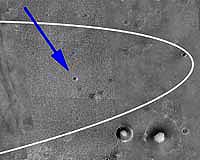
Opportunity landed far to the east of the landing ellipse. At this time no Narrow Angle MOC images from Mars Global Surveyor are available for the area the rover is believed to have lannded
 Opportunity landed far to the east of the landing ellipse. At this time no Narrow Angle MOC images from Mars Global Surveyor are available for the area the rover is believed to have lannded |
The crater is roughly 150 meters across, and has been tentatively estimated to be about 0.8 kilometers (about 0.5 miles) away from the lander, within easy driving distance of the rover.
DIMES images serve two purposes. The first is as a navigational aid. They help the lander determine how fast it's moving horizontally as it nears the surface. Too much horizontal motion is undesirable. The lander can compensate for this motion by firing onboard rockets. Spirit used these rockets during descent; they weren't necessary for Opportunity's descent.
The DIMES images also help mission scientists determine the lander's precise location. By comparing prominent landforms in the DIMES images with higher-resolution images taken by the MOC (Mars Orbital Camera) on the MGS (Mars Global Surveyor) orbiter, science team members can figure out precisely where Opportunity first impacted the martian surface.
Scientists believe Opportunity came to rest inside one of the small craters visible in the DIMES image. It could take as long as another week for them to figure out exactly which crater, however. While being in a crater is great for scientific exploration, it makes it difficult to see any of the surrounding landforms that might help pinpoint the lander's location.
That process, however, could take several more days. The lander used an airbag system to cushion it's impact, and the airbags can bounce and roll for as much as a kilometer before coming to rest. But no-one knows just how far - or in which direction it bounced.
Article is courtesy of NASA's Astrobiology Magazine team at Ames Research Center. This article is public domain and available for reprint with appropriate credit.
Related Links
 Pasadena - Jan 19, 2004
Pasadena - Jan 19, 2004 Pasadena - Sol 6-A, 2004
Pasadena - Sol 6-A, 2004SPACE.WIRE |